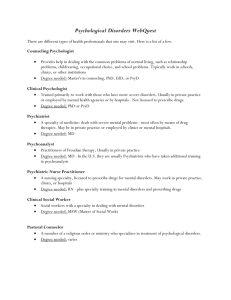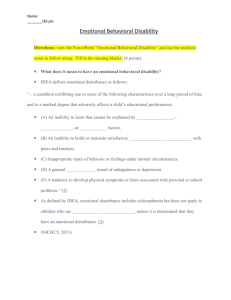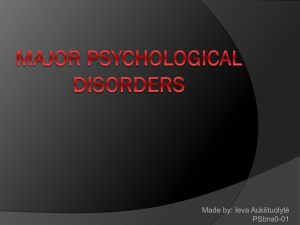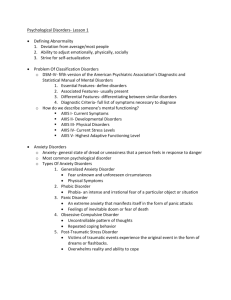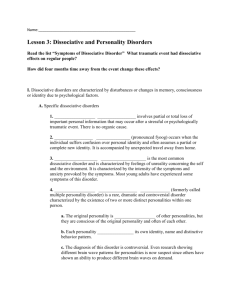AP Psychology – Review Session #4
advertisement
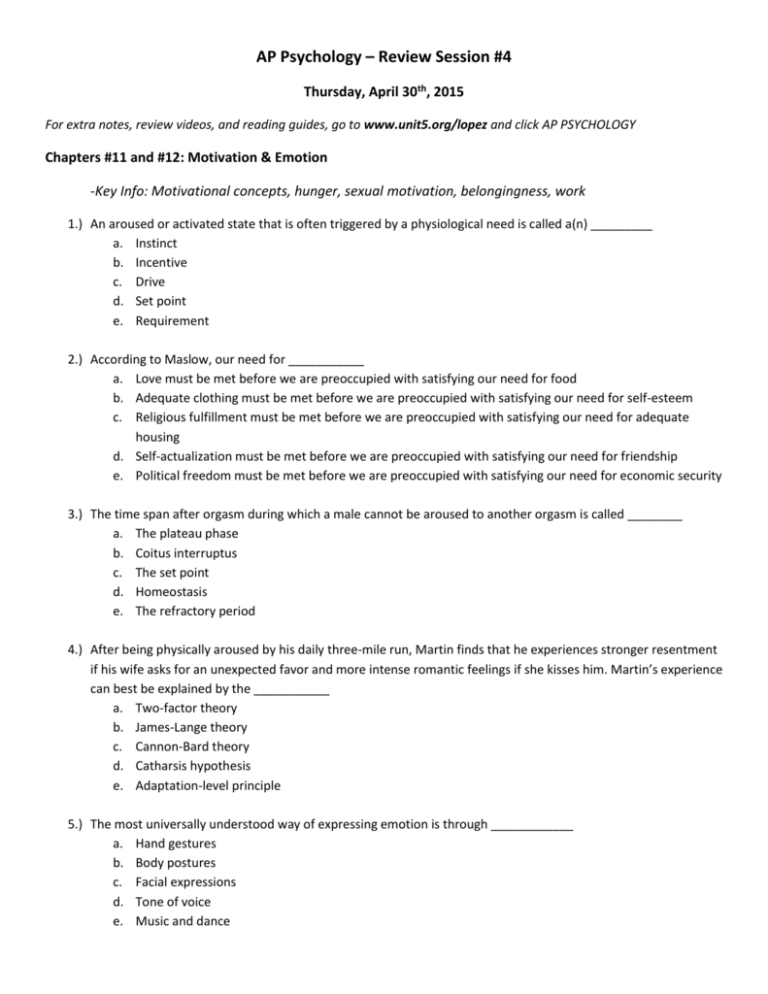
AP Psychology – Review Session #4 Thursday, April 30th, 2015 For extra notes, review videos, and reading guides, go to www.unit5.org/lopez and click AP PSYCHOLOGY Chapters #11 and #12: Motivation & Emotion -Key Info: Motivational concepts, hunger, sexual motivation, belongingness, work 1.) An aroused or activated state that is often triggered by a physiological need is called a(n) _________ a. Instinct b. Incentive c. Drive d. Set point e. Requirement 2.) According to Maslow, our need for ___________ a. Love must be met before we are preoccupied with satisfying our need for food b. Adequate clothing must be met before we are preoccupied with satisfying our need for self-esteem c. Religious fulfillment must be met before we are preoccupied with satisfying our need for adequate housing d. Self-actualization must be met before we are preoccupied with satisfying our need for friendship e. Political freedom must be met before we are preoccupied with satisfying our need for economic security 3.) The time span after orgasm during which a male cannot be aroused to another orgasm is called ________ a. The plateau phase b. Coitus interruptus c. The set point d. Homeostasis e. The refractory period 4.) After being physically aroused by his daily three-mile run, Martin finds that he experiences stronger resentment if his wife asks for an unexpected favor and more intense romantic feelings if she kisses him. Martin’s experience can best be explained by the ___________ a. Two-factor theory b. James-Lange theory c. Cannon-Bard theory d. Catharsis hypothesis e. Adaptation-level principle 5.) The most universally understood way of expressing emotion is through ____________ a. Hand gestures b. Body postures c. Facial expressions d. Tone of voice e. Music and dance 6.) The feel-good, do-good phenomenon refers to the fact that when people feel happy they _________ a. Are more willing to help others b. Perceive the world as a safer place c. Make decisions more effectively d. Experience a more positive self-image e. Report greater satisfaction with their whole lives Chapter #14 and #15: Disorders and Therapy -Key Info: Perspectives, anxiety disorders, somatoform disorders, dissociative disorders, mood disorders, schizophrenia, personality disorders 1.) In a study by David Rosenhan (1973), researchers were admitted as patients into various mental hospitals after they falsely claimed to be “hearing voices.” This study best illustrated the negative effects of _________ a. The medical model b. Psychoanalytic theory c. Hallucinations d. Linkage analysis e. Diagnostic labels 2.) Mrs. Swift is alarmed by her own intrusive and irrational thoughts that her house is contaminated with germs. Her experience best illustrates the agitating effects of ____________ a. A delusion b. Mania c. An obsession d. Agoraphobia e. Panic disorder 3.) College students were asked to pretend that they were accused murderers. Under hypnosis, they typically expressed a second personality when prompted to do so by the examining psychiatrist. This most strongly suggests that dissociative identity disorder may involve __________ a. Low self-esteem b. Unconscious fear c. Internal attributions of blame d. Role-playing e. Feelings of ambivalence 4.) During a stressful military battle, Fong suddenly went blind. When hypnotized by an army psychiatrist, his blindness vanished. Fong apparently suffered from a _________ a. Dissociative disorder b. Conversion disorder c. Generalized anxiety disorder d. Bipolar disorder e. Post-traumatic stress disorder 5.) In order to encourage Mrs. Coleman, a withdrawn schizophrenia patient, to be more socially active, institutional staff members give her small plastic cards whenever she talks to someone. She is allowed to exchange these cards for candy and cigarettes. Staff members are making use of ___________ a. Active listening b. Systematic desensitization c. A token economy d. Free association e. Classical conditioning 6.) Dr. Miller prescribes drugs for the treatment of chronic depression and she encourages rest and relaxation training for clients suffering from excessive anxiety. It is most likely that Dr. Miller is a ________ a. Clinical social worker b. Interpersonal therapist c. Cognitive therapist d. Psychiatrist e. Client-centered therapist Chapter #16: Social Psychology -Key Info: Social thinking, social influences, social relations 1.) An example of the fundamental attributional error is best illustrated in our tendency to underestimate the extent to which others’ behavior is influenced by ___________________ a. Genetics b. Assigned roles c. Their political philosophy d. Their level of motivation e. Personality traits 2.) Philip Zimbardo devised a simulated prison and randomly assigned college students to serve as prisoners or guards. This experiment best illustrated the impact of ____________ a. Team membership on social loafing b. Self-disclosure c. Frustration on aggression d. Role-playing on attitudes e. Groupthink on social thinking 3.) A culture that promotes individualism is most likely to encourage ______________ a. Altruism b. Nonconformity c. Ingroup bias d. Groupthink e. Superordinate goals 4.) University students were observed to pull harder on a rope when they thought they were pulling alone than when they thought three others were pulling with them on the same rope. This best illustrates ______ a. Social loafing b. The chameleon effect c. Group polarization d. Social facilitation e. Deindividuation 5.) When a group of white university women withheld criticism of a flawed essay written by a black fellow student, they demonstrated __________ a. The mere exposure effect b. Patronization c. Deindividuation d. The other-race effect e. Social traps 6.) Bullying younger students earns Diego the attention and respect of many classmates. As a result, his bullying behavior increases. This most clearly suggests that his aggression is a(n) ___________ a. Reaction to frustration b. Instinctive behavior c. Learned response d. Product of deindividuation e. Biologically triggered behavior






